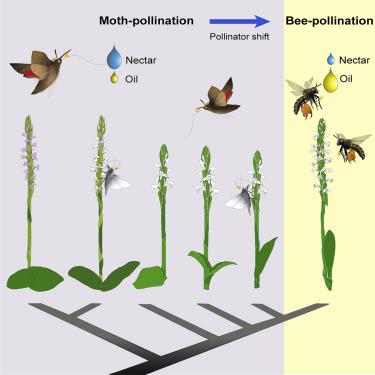Current Biology ( IF 8.1 ) Pub Date : 2020-11-05 , DOI: 10.1016/j.cub.2020.10.024 Miguel Castañeda-Zárate 1 , Steven D Johnson 1 , Timotheüs van der Niet 1

|
During the evolutionary history of flowering plants, transitions between pollinator groups (pollinator shifts) have been frequent,1 and contributed to the spectacular radiation of angiosperms.2 Although the evolution of floral traits during pollinator shifts has been studied in real time under controlled laboratory conditions,3 it is challenging to study in nature and therefore poorly understood.4, 5, 6, 7 Using a comparative, multidisciplinary approach, we dissect the evolution of floral traits during a pollinator shift in the long-spurred African orchid Satyrium longicauda. Phylogenetic analysis and ecological experiments revealed a shift from moth- to oil-collecting bee pollination. Remarkably, flowers of the bee-pollinated form are similar in morphology, color, and overall volatile chemistry to those of moth-pollinated forms, but differ in having spurs that are mostly devoid of nectar, and have an elevated presence of the oil-derived compound diacetin, which oil-collecting bees use as a cue for oil presence.8 Experiments demonstrated that long spurs are critical for pollination of a moth-pollinated form, but are not needed for pollination of the bee-pollinated form. We conclude that the pollinator shift in Satyrium was mediated by a switch in chemistry of the pollinator reward. The ancestral presence of diacetin might have served as a pre-adaptation for bee pollination, whereas the current mismatch between flower morphology and bees is due to the retention of vestigial floral spurs. These results elucidate the sequence of floral evolution in the early stages of pollinator shifts and help to explain the assembly of suites of co-varying traits through pre-adaptation and vestigialization.9, 10, 11, 12
中文翻译:

食物奖励化学解释了兰花中长花刺的新传粉者转移和退化
在开花植物的进化历史中,传粉者群体之间的转变(传粉者转变)很频繁,1并促成了被子植物的壮观辐射。2尽管已经在受控实验室条件下实时研究了传粉者转变过程中花卉性状的演变3,但在自然界中进行研究具有挑战性,因此了解甚少。 4, 5, 6, 7 我们使用比较、多学科的方法进行剖析在长期受刺激的非洲兰花Satyrium longicauda传粉者转变期间花卉性状的演变. 系统发育分析和生态实验揭示了蜜蜂授粉从飞蛾到油采集的转变。值得注意的是,蜜蜂授粉形式的花在形态、颜色和整体挥发性化学方面与蛾类授粉形式相似,但不同之处在于其花刺几乎没有花蜜,并且油衍生的花更多复合双醋精,采油蜜蜂将其用作油存在的线索。8实验表明,长刺对于蛾授粉形式的授粉至关重要,但对于蜜蜂授粉形式的授粉则不需要。我们得出结论,Satyrium的传粉媒介转移是由传粉者奖励的化学变化介导的。双醋精的祖先存在可能是蜜蜂授粉的预适应,而目前花朵形态和蜜蜂之间的不匹配是由于保留了残留的花刺。这些结果阐明了传粉者转变早期阶段的花进化顺序,并有助于解释通过预适应和退化来组装一组共变性状。 9, 10, 11, 12











































 京公网安备 11010802027423号
京公网安备 11010802027423号